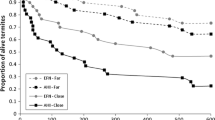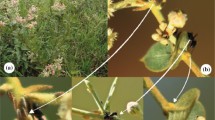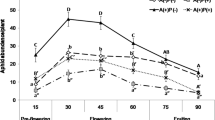Abstract
When aphids parasitize plants with extrafloral nectaries (EFNs) and aphid colony size is small, ants frequently use EFNs but hardly tend aphids. However, as the aphid colony size increases, ants stop using EFNs and strengthen their associations with aphids. Although the shift in ant behavior is important for determining the dynamics of the ant–plant–aphid interaction, it is not known why this shift occurs. Here, we test two hypotheses to explain the mechanism responsible for this behavioral shift: (1) Extrafloral nectar secretion changes in response to aphid herbivory, or (2) plants do not change extrafloral nectar secretion, but the total reward to ants from aphids will exceed that from EFNs above a certain aphid colony size. To judge which mechanism is plausible, we investigated secretion patterns of extrafloral nectar produced by plants with and without aphids, compared the amount of sugar supplied by EFNs and aphids, and examined whether extrafloral nectar or honeydew was more attractive to ants. Our results show that there was no inducible extrafloral secretion in response to aphid herbivory, but the sugar concentration in extrafloral nectar was higher than in honeydew, and more ant workers were attracted to an artificial extrafloral nectar solution than to an artificial aphid honeydew solution. These results indicate that extrafloral nectar is a more attractive reward than aphid honeydew per unit volume. However, even an aphid colony containing only two individuals can supply a greater reward to ants than EFNs. This suggests that the ant behavioral shift may be explained by the second hypothesis.


Similar content being viewed by others
References
Allen GR (1972) The anemonefishes: their classification and biology. T.F.H. Publications, Neptune City
Becerra JXI, Venable DL (1989) Extrafloral nectaries: a defense against ant-Homoptera mutualisms? Oikos 55:276–280
Bentley BL (1977) Extrafloral nectaries and protection by pugnacious bodyguards. Annu Rev Ecol Evol Syst 8:407–427
Boucher DH, James S, Keeler KH (1982) The ecology of mutualism. Annu Rev Ecol Evol Syst 13:315–347
Buckley R (1983) Interaction between ants and membracid bugs decreases growth and seed set of host plant bearing extrafloral nectarines. Oecologia 58:132–136
Buckley RC (1987) Interactions involving plants, Homoptera, and ants. Annu Rev Ecol Evol Syst 18:111–135
Dixon AFG (1998) Aphid ecology. Chapman and Hall, London
Engel V, Fischer MD, Wäckers FL, Völkl W (2001) Interactions between extrafloral nectaries, aphids and ants: are there competition effects between plant and homopteran sugar sources? Oecologia 129:577–584
Fischer MK, Shingleton AW (2001) Host plant and ants influence the honeydew sugar composition of aphids. Funct Ecol 15:544–550
Fischer MK, Hoffmann KH, Völkl W (2001) Competition for mutualists in an ant-homopteran interaction mediated by hierarchies of ant attendance. Oikos 92:531–541
Fischer MK, Völkl W, Schopf R, Hoffmann KH (2002) Age-specific patterns in honeydew production and honeydew composition in the aphid Metopeurum fuscoviride: implications for ant-attendance. J Insect Physiol 48:319–326
Gaume L, McKey D, Terrin S (1998) Ant-plant-homopteran mutualism: how the third partner affects the interaction between a plant-specialist ant and its myrmecophyte host. Proc R Soc Lond B 265:569–575
Heil M, Koch T, Hilpert A, Fiala B, Boland W, Linsenmair KE (2001) Extrafloral nectar production of the ant-associated plant, Macaranga tanarius, is an induced, indirect, defensive response elicited by jasmonic acid. Proc Natl Acad Sci USA 98:1083–1088
Helden MV, Tjallingii WF, van Beck TA (1994) Phloem sap collection from lettuce (Lactuca sativa L.): chemical comparison among collection methods. J Chem Ecol 20:3191–3206
Herre EA, Knowlton N, Mueller UG, Rehner SA (1999) The evolution of mutualisms: exploring the paths between conflict and cooperation. Trends Ecol Evol 14:49–53
Katayama N, Suzuki N (2002) Cost and benefit of ant attendance for Aphis craccivora (Hemiptera: Aphididae) with reference to aphid colony size. Can Entomol 134:241–249
Katayama N, Suzuki N (2003a) Changes in the utilization of extrafloral nectaries of Vicia faba (Leguminosae) and honeydew of aphids by ants with increasing aphid density. Ann Entomol Soc Am 96:579–584
Katayama N, Suzuki N (2003b) Bodyguard effects for aphids of Aphis craccivora Koch (Homoptera: Aphididae) as related to the activity of two ant species, Tetramorium caespitum Linnaeus (Hymenoptera: Formicidae) and Lasius niger L. (Hymenoptera: Formicidae). Appl Entomol Zool 38:427–433
Katayama N, Suzuki N (2004) Role of extrafloral nectaries of Vicia faba for attraction of ants and herbivores exclusion by ants. Entomol Sci 7:117–122
Katayama N, Suzuki N (2005) The importance of the encounter rate between ants and herbivores and of ant aggressiveness against herbivores in herbivore exclusion by ants on Vicia angustifolia L. (Leguminosae) with extrafloral nectaries. Appl Entomol Zool 40:69–76
Katayama N, Suzuki N (2010) Extrafloral nectaries indirectly protect small aphid colonies via ant-mediated interactions. Appl Entomol Zool 45:505–511
Kawano S, Azuma H, Ito M, Suzuki K (1999) Extrafloral nectaries and chemical signals of Fallopia japonica and Fallopia sachalinensis (Polygonaceae), and their roles as defense systems against insect herbivory. Plant Species Biol 14:167–178
Koptur S (1979) Facultative mutualism between weedy vetches bearing extrafloral nectaries and weedy ants in California. Am J Bot 66:1016–1020
Koptur S (1992) Extrafloral nectary-mediated interactions between insects and plants. In: Bernays E (ed) Insect–plant interaction Vol, IV. CRC press, Boca Raton, pp 81–129
Linsenmair KE, Heil M, Kaiser WM, Fiala B, Koch T, Boland W (2001) Adaptations to biotic and abiotic stress: Macaranga-ant plants optimize investment in biotic defence. J Exp Bot 52:2057–2065
Ness JH (2003) Catalpa bignonioides alters extrafloral nectar production after herbivory and attracts ant bodyguards. Oecologia 134:210–218
Offenberg J (2000) Correlated evolution of the association between aphids and ants and the association between aphids and plants with extrafloral nectaries. Oikos 91:146–152
Offenberg J (2001) Balancing between mutualism and exploitation: the symbiotic interaction between Lasius ants and aphids. Behav Ecol Sociobiol 49:304–310
Ohgushi T, Craig TP, Price PW (2007) Ecological communities: plant mediation in indirect interaction webs. Cambridge University Press, Cambridge
Ruffner GA, Clark WD (1986) Extrafloral nectar of Ferocactus acanthodes (Cactaceae): composition and its importance to ants. Am J Bot 73:185–189
Sakata H (1994) How an ant decides to prey on or to attend aphids. Res Popul Ecol 36:45–51
Sakata H (1995) Density-dependent predation of the ant Lasius niger (Hymenoptera: Formicidae) on two attended aphids Lachnus tropicalis and Myzocallis kuricola (Homoptera: Aphididae). Res Popul Ecol 37:159–164
Sakata H, Hashimoto Y (2000) Should aphids attract or repel ants? Effect of rival aphids and extrafloral nectaries on ant-aphid interactions. Popul Ecol 42:171–178
Smith SE, Read DJ (1997) Mycorrhizal symbiosis. Academic Press, San Diego
Stadler B, Dixon AFG (1998) Costs of ant attendance for aphids. J Anim Ecol 67:454–459
Strauss Y, Irwin RE (2004) Ecological and evolutionary consequences of multispecies plant-animal interactions. Annu Rev Ecol Evol Syst 35:435–466
Suzuki N, Ogura K, Katayama N (2004) Efficiency of herbivore exclusion by ants attracted to aphids on the vetch Vicia angustifolia L. (Leguminosae). Ecol Res 19:275–282
Takizawa T, Yasuda H (2006) The effects of attacks by the mutualistic ant, Lasius japonicus Santschi (Hymenoptera: Formicidae) on the foraging behavior of the two aphidophagous ladybirds, Coccinella septempunctata brucki Mulsant (Coleoptera: Coccinellidae) and Propylea japonica (Thunberg) (Coleoptera: Coccinellidae). Appl Entomol Zool 41:161–169
Thompson JN (2005) The geographic mosaic of coevolution. The University of Chicago Press, Chicago
Ueda S, Quek S-P, Itioka T, Inamori K, Sato Y, Murase K, Itino T (2008) An ancient tripartite symbiosis of plants, ants and scale insects. Proc R Soc Lond B 275:2319–2326
Völkl W, Woodring J, Fischer M, Lorenz MW, Hoffmann KH (1999) Ant-aphid mutualisms: the impact of honeydew production and honeydew sugar composition on ant preferences. Oecologia 118:483–491
Wäckers FL, Bonifay C (2004) How to be sweet? Extrafloral nectar allocation by Gossypium hirsutum fits optimal defense theory predictions. Ecology 85:1512–1518
Way MJ (1963) Mutualism between ants and honeydew-producing Homoptera. Annu Rev Entomol 8:307–344
Wimp GM, Whitham TG (2001) Biodiversity consequences of predation and host plant hybridization on an aphid—ant mutualism. Ecology 82:440–452
Yao I, Akimoto S (2001) Ant attendance changes the sugar composition of the honeydew of the drepanosiphid aphid Tuberculatus quercicola. Oecologia 128:36–43
Acknowledgments
We are deeply grateful to Ryohei Yamaoka for permission to use equipment at Kyoto Institute of Technology and for his helpful advice and support during this study. We also thank Hideki Kagata, Tetsuhiro Kawagoe at Kyoto University, and two reviewers for their helpful comments in this research. This study was partly supported by a JSPS Research Fellowship for Young Scientists to N. Katayama.
Author information
Authors and Affiliations
Corresponding author
Additional information
Nobuhiko Suzuki: Deceased.
About this article
Cite this article
Katayama, N., Hembry, D.H., Hojo, M.K. et al. Why do ants shift their foraging from extrafloral nectar to aphid honeydew?. Ecol Res 28, 919–926 (2013). https://doi.org/10.1007/s11284-013-1074-5
Received:
Accepted:
Published:
Issue Date:
DOI: https://doi.org/10.1007/s11284-013-1074-5




